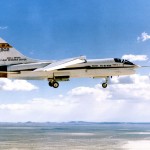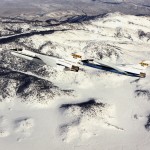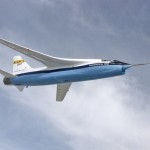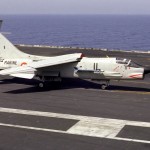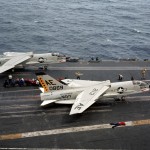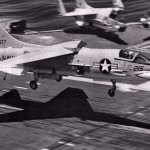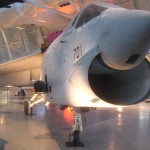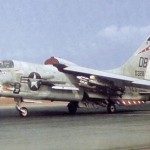
The “Crusader” was a single-engine, carrier-based jet aircraft designed for air-to-air combat. It was first flown in 1955, had a top speed of just under Mach 1.9 and was the last American fighter aircraft to rely on guns as its primary weapon, although it could fire guided missiles as well. The fighter was the first to engage enemy MiGs in the Vietnam war.
In 1952, the United States Navy gave new specifications for a fighter. It was looking for a day fighting supersonic jet with a fast climb rate and 20 mm guns instead of 12.7 mm machine guns, which were no longer effective in modern air combat.
In response, Vought created the V-383 with a high-mounted wing that allowed shorter, lighter landing gear. The oddest part of the design was the 5-degree variable-incidence wing, which increased lift at takeoff and landing.
The F-8, which the prototype evolved into, quickly became the favored daytime fighter for the Navy. It was agile and reliable, but proved a challenge to fly. It was a very unforgiving aircraft, particularly during carrier landings. Oddly enough, the aircraft was actually able to fly with its wings still folded in for carrier storage. There were several occurrences of pilots taking off, wings folded, and being able to return to base and land successfully.
During the Cuban Missile Crisis in 1962, the F-8 served in perhaps its most valuable role. The unarmed RF-8A reconnaissance variant took low altitude, highly detailed photographs over Cuba, confirming that the Soviet Union was setting up nuclear missiles in Cuba. The RF-8As also flew missions to confirm that the missiles were being withdrawn at the end of the crisis. The pilots who flew these missions received the Distinguished Flying Cross for their efforts, which represent the first operational use of the F-8 in any form.
At the beginning of Vietnam, the F-8 was the first American airplane to engage the North Vietnamese Air Force MiG-17s on April 3, 1965. Although the F-8 was largely supplanted by the F-4 Phantom II during the length of the war, the F-8 had the best kill ratio, 19:3 of any American aircraft, although the Vietnamese claim more than three F-8s were shot down.
Sixteen of the F-8’s air kills came against the agile MiG-17, and three came against the MiG-21.
The F-8 — and the F-8 pilots — proved invaluable as dogfighters. As the AIM-7 “Sparrow” radar-guided missile came into popularity, many people believed that close air-to-air combat would become a thing of the past. They believed missiles would swat any enemy out of the sky. This proved not to be the case, and the F-8’s maneuverability, combined with the learned skills of its pilots, made a big difference. Air combat maneuvering became an essential training tool once this lesson was learned.
A total of 1,219 F-8s would be built, with the last delivery coming in 1964. The Navy retired the F-8 in 1987.

The F-8 would make its most notable contributions to aviation with NASA, which used the F-8 as a testbed for an early digital fly-by-wire system as well as supercritical wing trials. The IBM fly-by-wire system tested and debugged on the F-8 would later be used on the Space Shuttle.
Elements from the F-8’s design would be used by Vought to create its second successful carrier jet, the A-7 Corsair II attack craft.
Specifications
General
Crew: One
Length: 54 ft 3 in
Wingspan: 35 ft 8 in
Height: 15 ft 9 in
Empty weight: 17,541 lb
Loaded weight: 29,000 lb
Engine: One Pratt & Whitney J57-P-20A afterburning turbojet
Performance
Maximum speed: Mach 1.86 (1,225 mph) at 36,000 ft
Cruise speed: 570 mph
Combat radius: 450 mi
Range: 1,735 mi with external fuel
Ceiling: 58,000 ft
Thrust/weight: 0.62
Armament
Guns: Four 20 mm Colt Mk 12 cannons in lower fuselage
Missiles: AIM-9C Sidewinders or Matra Magic (French only). AGM-12 Bulpup
Rockets: Zuni rockets
Bombs: 12 250 lb Mark 81 bombs or Eight 500 lb Mark 82 bombs or Four 1,000 lb Mark 83 bombs or Two 2,000 lb Mark 84 bombs
Essential Reading
There are a lot of books about the F-8. It has a special place in many pilots’ hearts, and it is famous for its kill ratio in Vietnam.
Online Resources:
- Wikipedia — Can’t miss it
- The Gunfighter’s Page — An original “Web 1.0” site and what we’d call the definitive F-8 website
- Dryden Flight Research Center — Fly-by-Wire and Supercritical Wing fact sheets

